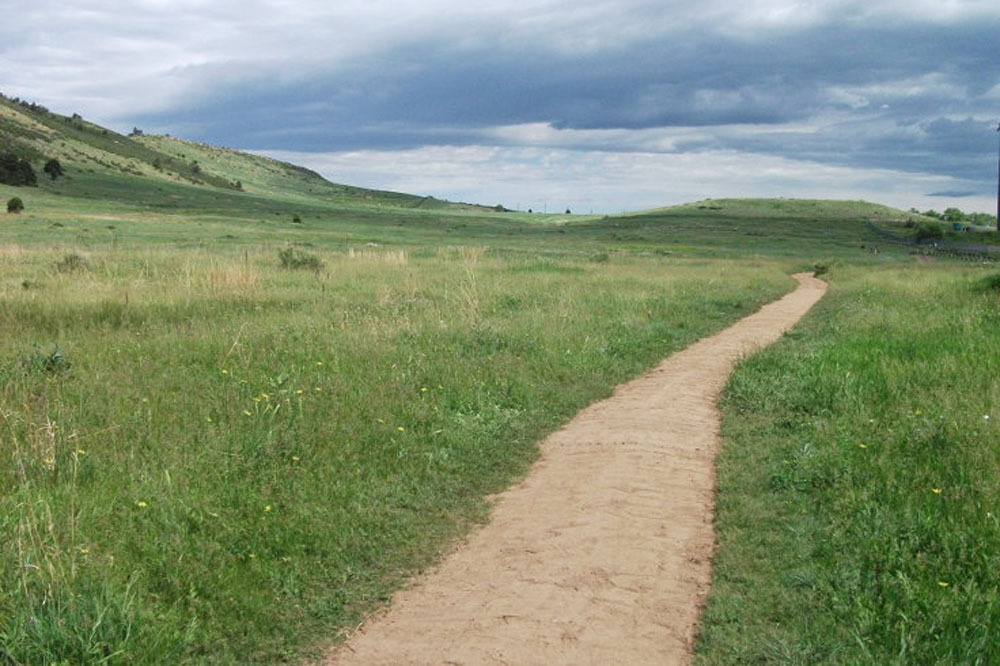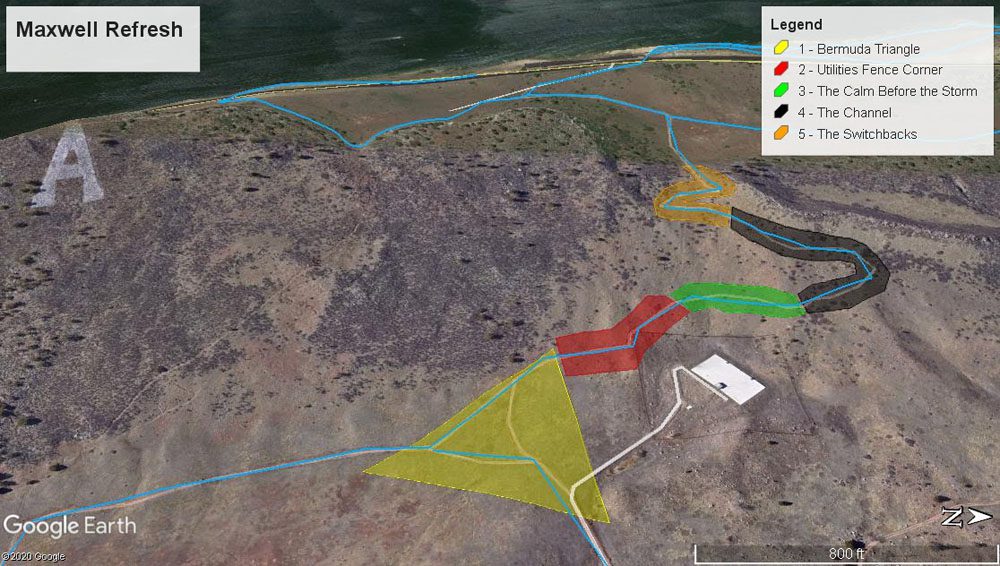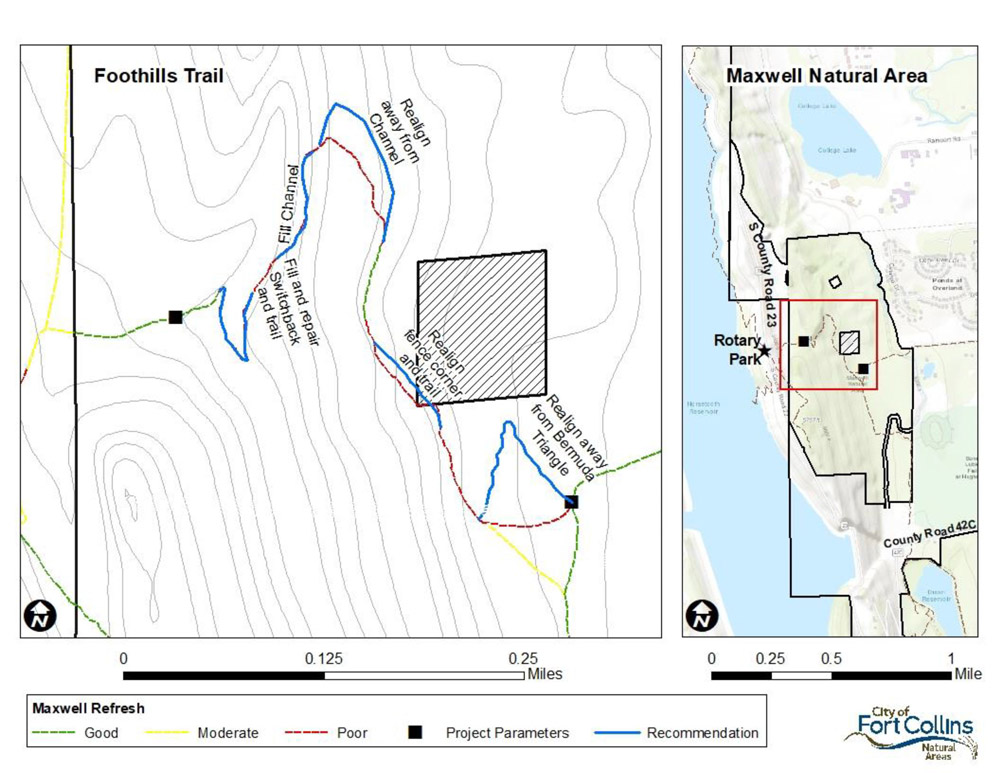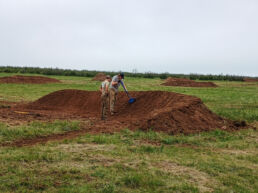
Foothill Master Plan Information
The management plan that applies to Coyote Ridge, Pineridge, Maxwell and Reservoir Ridge natural areas and the Foothills Trail was updated in 2019.
https://www.fcgov.com/naturalareas/foothills-plan/
The following information was provided by the Overland Mountain Bike Association.
FC Natural Areas to Begin Work on Maxwell Trail
Many of you attended open houses and submitted comments for the Foothills Management Plan last year. At that time the City was examining a potential alternate-day system of access that would have cut access by 50% for bikes to Maxwell and essentially the rest of the Foothills Trail. Thanks to overwhelming feedback from our community this policy decision was not implemented. This was a big win for the trails community! Another part of this plan was to hire an independent trail building consultant and form a stakeholder group to help determine a better course of action for a Maxwell Trail refresh project. This all happened in August & September, and Fort Collins Natural Areas staff has now released their work plan for this popular trail.
As informed by FCNA staff, work is scheduled to begin in early 2021 with a few full trail closures likely during the construction process. Work will be done in stages to minimize the disruption to trail users. The trail has been divided into 5 different sections with work being focused on 1 section at a time, starting with section 1 below. Completion is currently scheduled for Summer 2021.
The following information was provided to all stakeholders by Fort Collins Natural Areas as their official work plan for the Maxwell Refresh Project (see map below for section reference):
1. The Bermuda Triangle
a. Repair existing 200’ section of “fall-line” trail by excavating, installing geocell fabric (or similar material), and backfilling to grade with amended tread material.
Considerations: No new trail constructed, maintains efficiency for users, does not adequately address excessive speeds in the area (however the trail is wide enough for users to pass each other or step to the side), potential for continued erosion.
2. Utilities Fence Corner
a. Move fence corner. Realign 350’ trail to a more sustainable grade. Close existing trail, install erosion barriers, fencing signage and seed.
Considerations: Improves line of site, safety, and eliminates user erosion caused by disc brakes.
3. The Calm Before the Storm
a. Continue general maintenance on this section of trail with no improvements.
Considerations: This is one of the most sustainable sections of trail at Maxwell, some discussion was raised during stakeholder events about it needing to be wider.
4. The Channel
a. Realign 400’ of this section of trail east of the existing trail corridor. Close existing trail. Install erosion barriers, native seed, fencing, and signage.
b. For the remaining 600’ of this section, install large boulder checks at 20’ intervals and fill eroded trail back to grade with 150 tons of imported soil transported by air lift (see map).
Considerations: Realignment will impact an estimated acre of three leaf sumac community, potential trail grade issues with realignment, concerns about losing imported soil via erosion, filling trail back to grade restores trail’s ability to sheet precipitation across its surface.
5. The Switchbacks
a. Extend switchback retaining structure 50’ to the south.
b. Fill switchback structure, improve turning radius, and repair drainage capabilities of this section of trail with 100 tons of imported soil transported via air lift (see map).
Considerations: does not impact any plant communities.
A few other things to note from our conversations with FCNA staff…
- FCNA staff hired a highly respected trail builder to consult on this project
- FCNA staff stated they intend to keep some of the existing challenging technical aspects to keep the “fun factor” high for mountain bikes and other trail users, but some of those will be removed given the scope of the project
- Helicopters and other heavy equipment will be used to bring in material to fill heavily eroded sections.
- There will be no separation of use or in direction of travel
- Trail width of 36” will be targeted
- A custom soil blend will be used to increase soil cohesion & durability; will not be a crushed-gravel/road base material
- All work will be completed by FCNA staff and hired contractors; volunteers may be asked for help with completion of certain segments in 2021
- All work is expected to be completed by Summer 2021
- OMBA was not involved with the development of this work plan other than our participation in the stakeholder group
We have mixed feelings on this plan. The work is absolutely needed. Maxwell has steep grades that far exceed standards for any multi-use trail. This is one of the major causes of Maxwell’s trail braiding/widening & severe erosion (3’ deep in some areas). This work plan addresses that issue in a good way. Restoring damaged sections of trail, bringing trail grades to a more sustainable level, and keeping a certain amount of technical challenge are all positives and highly needed. FCNA staff deciding to reroute portions of the existing trail when this appeared to not be an option previously is definitely a positive. Using a blended soil for added durability instead of the crushed-gravel material as done in Pineridge and other areas should provide a good riding surface while further reducing erosion. We see this work plan as a positive way to address the more immediate resource impacts.
However…there was a great opportunity to do something much more innovative & unique for this iconic Fort Collins trail, yet we see this decision as simply maintaining the status quo. Multiple stakeholders, FCNA staff and the consultant actively discussed options for smaller sections of paralleling trails to help separate by type of use, direction of travel & ability level. When such a highly respected trail builder says he would like to rebuild Maxwell into one of the best & most unique mountain biking & multi-use trails in the country, that’s something to really get excited about. Yet FCNA staff chose not to do this, and that’s disappointing. In OMBA’s opinion, there is no reason why we can’t have an innovative, creative & unique trail that focuses on meeting or exceeding user experience expectations while also protecting and enhancing the natural surroundings…we really can and should have both.
The official work plan as described above will benefit the sustainability of the existing trail. Not addressing the larger and overarching issue of funneling all users and ability levels onto a single heavily-used trail is a missed opportunity. Trail use in this area will continue to increase sharply every year…we all know that. If FCNA leadership does not address this issue now, then when?
OMBA greatly appreciates the stakeholder process and the work FCNA staff are putting into this project. The multiple issues impacting Maxwell Trail and the surrounding landscape make this a VERY challenging project. This level of maintenance & refresh has been needed for some time. All the various user groups and interests will continue to have the same access. Our additional request is that the lack of trail supply vs trail demand be made a primary focus as well.








